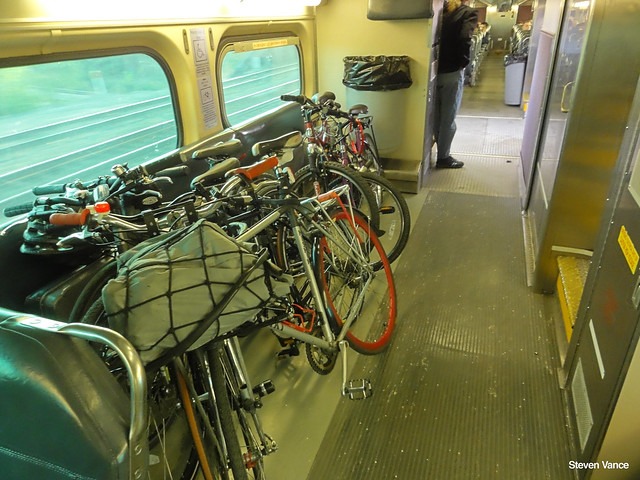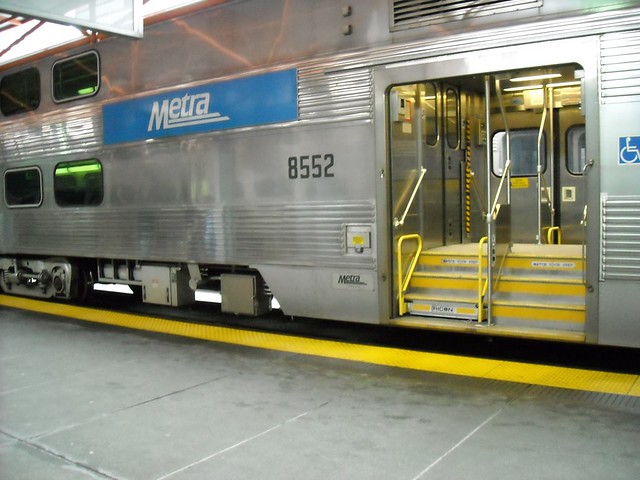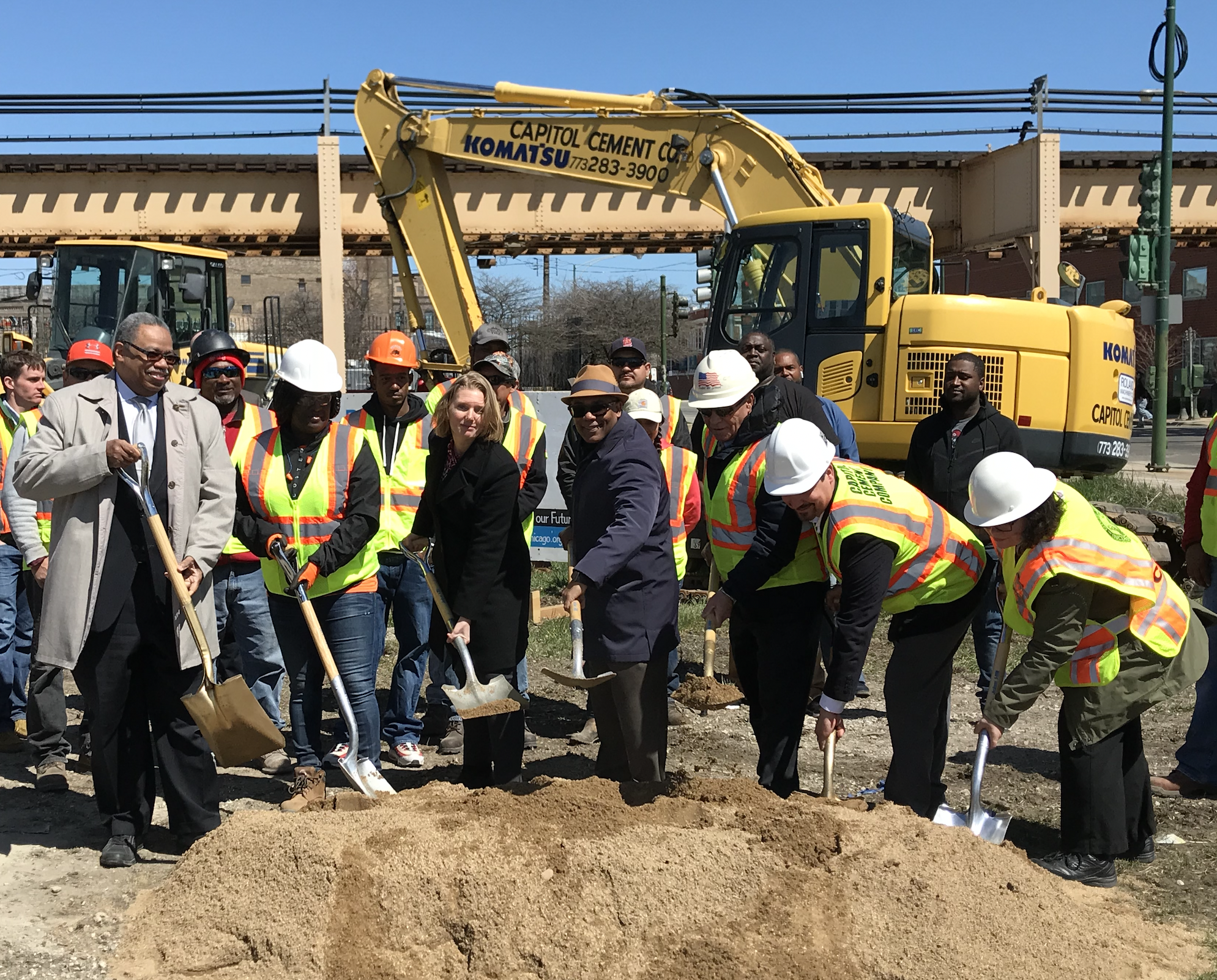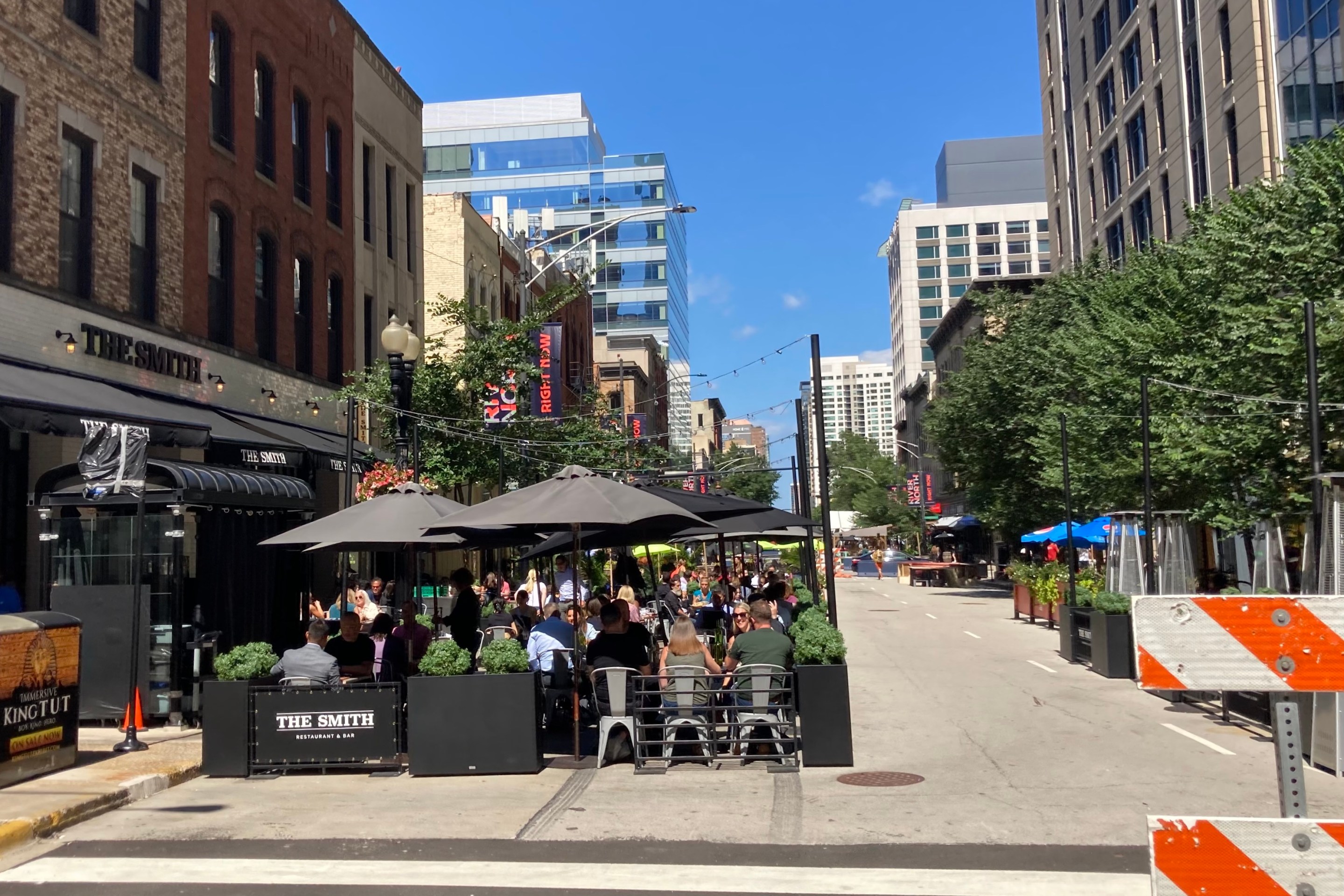Bike Access on Metra: Two Steps Forward, One Step Back
2:09 PM CDT on April 19, 2013
Anne Alt is president of the Chicago Cycling Club and works in the Law Offices of James Freeman, a sponsor of Streetsblog Chicago.
When legislation encouraged by then-Lt. Governor Pat Quinn allowed non-folding bikes on Metra trains for the first time in 2005, it was a long-sought victory for Chicago area cyclists. Gaining a new way to transport bikes has allowed thousands to take car-free trips throughout the metro area for transportation and recreation.
The user experience and degree of access has varied and evolved since then. The number of blackout dates when bikes are not allowed has steadily shrunk, with some assistance from our friends at the Active Transportation Alliance. Seeing bikes on Metra trains has become a daily occurrence. This inspired one rider to write a user’s guide and another to create a "Can I bring my bike on Metra right now?" app.
In the early years, conductors or station security staff, unfamiliar with the new bike policy, often prevented cyclists from bringing their bikes on board, even when the schedules available in print and online stated that bikes would be allowed on that train. Unannounced blackout dates were not unusual. Metra policy required a bungee cord to secure the bike so it couldn't roll while the train was in motion. Cyclists who were infrequent passengers, or new to taking bikes on Metra, weren't all aware of this and were sometimes denied boarding if they didn’t have a bungee cord. If there were conflicts with other passengers over use of the designated bike space, conductor assistance was uncommon. Over the last several years, conductors have become familiar with the bike policy and their treatment of cyclists has improved.
Some conductors have even used Metra to bring their own bikes downtown to use when they’re not working. Now they’re more likely to allow some improvisation for securing a bike on the train (such as a belt, cable lock, or U-lock) if a rider does not have a bungee cord. A small change made to the policy helps with those situations. "Bicycles must be secured to the lower rail of folding seats in the priority seating area with long bungee cords (approximately 36 inches recommended) or other devices supplied by the cyclist which adequately secure the bicycle."
Some of us who ride Metra regularly have noticed the impact of an unadvertised budget measure on bike access: a reduction in the number of open ADA accessible cars on off-peak trains. ADA accessible cars are the only ones where non-folding bikes are allowed. Due to variations in operating procedures and differences in ridership between Metra lines, this change affects some lines more than others. The bike capacity advertised on Metra’s bike policy page and in schedules is based on having 2-4 open ADA cars per train (varying by line and run) and space for up to five bikes per ADA car on diesel trains (increased from three in 2010), and a two-bikes-per-car limit on Metra Electric.
All Metra Electric cars are accessible, with platform-level entry vestibules. On other lines, the number of accessible cars per diesel trainset varies, but is usually less than half the total number of cars. There are many older, non-accessible cars still in use in the Metra system with stairs, but no lifts. The limited number of ADA cars isn’t just an issue for cyclists. We are competing for space with disabled passengers, families with children in strollers, and travelers with suitcases, so the space limitation affects all these Metra riders. A cyclist can lose out by getting bumped if space becomes too tight. When the number of open cars (particularly ADA cars) is too low for the number of boarding passengers (a frequent issue on weekends and holidays), train delays result and everyone loses.
I asked local cyclists to share their Metra experiences through a survey. About half of survey respondents (48 out of 98) are reverse commuters. Some are daily, year-round bike-train commuters, while others use this as an occasional option. Several respondents regularly use a folding bike to avoid space conflicts and eliminate the possibility that they could be denied boarding. (Metra policy allows folding bikes, folded and bagged, on all trains at any time.)
The vast majority of respondents have been taking their bikes on Metra for a year or more. I’ve been doing it with regular bikes since they were first allowed in 2005, and for a few years prior to that with a bagged folding bike.
Unless one is a regular rider on a specific line, it's difficult to anticipate whether available bike space on a train will be as advertised or less. My experience on the Rock Island has changed significantly since 2005. At first, bike capacity was usually as-advertised, with two-to-three open ADA cars on most off-peak runs. As ridership has declined (from 9,933,379 in 2006 to 8,500,360 in 2012), the number of open ADA cars and the number of ADA cars per trainset has been reduced. Most six-car Rock Island trainsets now have only two ADA cars instead of three, with only one ADA car open on most off-peak runs.
Inconsistent experiences
Many survey respondents commented that their experience varies, and can depend on the personality and mood of the individual conductor. Some conductors are extremely helpful to cyclists and may assist in resolving space conflicts so that everyone can ride.
Reverse commuter Anna Schibrowsky rides the Milwaukee District North and the Union Pacific West (and other lines on occasion). "I've met other Metra reverse commuters who would love to take their bikes on Metra, but their reverse commutes begin on an inbound train (regular commute) and continue after transferring to an outbound train (reverse commute) downtown," she said. "Since bikes aren't allowed on the first leg, they usually don't bike at all. Like me, they are concerned about leaving their bikes locked up at the station all day."
Erick 'Iggy' Ignaczak, a daily reverse commuter on the Milwaukee District West line, commented that he’s always seen space available on his train on weekday festival blackout dates. He mentioned there were conflicts on the train during the Ryder Cup golf tournament with passengers who were unaware of Metra’s bike policy.
In describing his experiences on the UP-North line, Ryan Morris said that he has seen situations where conductors turned cyclists away. He observed that "most conductors are the rudest when there are cyclists who are dumb (taking up too much space, not stacking well, not waiting for people)." He’s seen conductors ask other passengers to move from ADA spaces and usually seen cooperation with those requests. He added that, without conductor help, it can be a challenge to persuade people that bikes have priority in the ADA spaces (below that of senior citizens and persons with disabilities), but that a smile and a simple explanation often make the difference.
Riders who provided detailed comments mentioned problems on nearly all Metra lines with denial of boarding due to lack of space, most frequently on BNSF (the highest ridership line*) and Metra Electric. One third of respondents indicated they'd been denied boarding or were forced to leave a train because there was no room for their bike. On the Rock Island line, which I use to travel between Beverly and the Loop, I sometimes encounter inbound trains that are too crowded to board. In these situations, there are usually only one or two ADA cars open and lots of passengers with big suitcases and strollers. I often encounter passengers in wheelchairs on my off-peak trips, and I see a lot of cooperation between them and cyclists in sharing the designated ADA area on trains.
Metra is a valuable option for multi-modal travel throughout the metro area. However, until Metra makes physical improvements to better accommodate the mix of passengers who require accessible cars, or more cars are available, it will be an imperfect solution that isn’t always reliable for meeting our transportation needs. Perhaps if Metra made an operational change and switched to placing ADA cars back to back in all trainsets and having at least two ADA cars open on every run, they could better accommodate the typical mix of users on off-peak runs. I will be curious to see how bike access on Metra evolves over the next several years.
* Average annual BNSF ridership over the last 8 years (15,148,519) has been about 35% higher than the second and third highest lines (Metra Electric 9,898,240 and UP-Northwest 9,629,535).
Read More:
Stay in touch
Sign up for our free newsletter
More from Streetsblog Chicago
Pressure is mounting to replace embattled CTA President Dorval Carter
Here's a look at what elected officials and other media outlets have said about the issue recently.
Service boost means BNSF Line will get Metra’s first-ever across-the-board weekend schedule, starting April 29
In addition, Halsted Street station will get weekend service, and Downers Grove's Fairview stop will become an off-peak stop.
Tasty news: Friedman Properties is trying to break the Clark outdoor dining stalemate by applying for street closure permits
Mayor Johnson's administration and Ald. Reilly haven't yet found common ground on bringing back the popular car-free zone. Will this make the difference?





